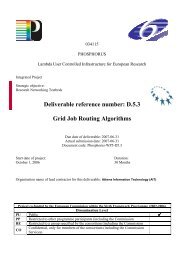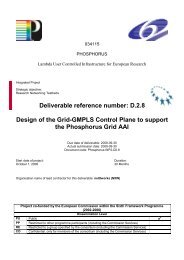D5.9: Extended Simulation Environment - Phosphorus
D5.9: Extended Simulation Environment - Phosphorus
D5.9: Extended Simulation Environment - Phosphorus
Create successful ePaper yourself
Turn your PDF publications into a flip-book with our unique Google optimized e-Paper software.
D5.6 - <strong>Extended</strong> <strong>Simulation</strong> <strong>Environment</strong><br />
2 Dimensioning and Fault Tolerance<br />
<strong>Simulation</strong> Studies for Data-Intensive<br />
Applications<br />
The <strong>Phosphorus</strong> project is in large part dedicated to studying network-related aspects of Grid computing, and<br />
thus its focus is on data-intensive applications that are heavily dependent on network resources. In this context,<br />
we identified the crucial concept of Data Consolidation (DC) that applies to applications that need several<br />
pieces of data scattered in a number of Grid resources. The DC problem consists of three interrelated subproblems:<br />
(i) the selection of the replica of each dataset (i.e., the data repository site from which to obtain the<br />
dataset) that will be used by the job, (ii) the selection of the site where these pieces of data will be gathered and<br />
the job will be executed and (iii) the selection of the paths the datasets will follow to arrive at the data<br />
consolidating site.<br />
We examined the Data Consolidation (DC) operation in a number of <strong>Phosphorus</strong> deliverables, namely [2] and<br />
[3], by considering network design, resource placement and fault tolerance issues. In [2] we proposed a<br />
number of simple Data Consolidation techniques and examined how they are affected by the network design. In<br />
particular, we investigated the effect of the total number of storage resources and the effect of the placement of<br />
storage resources and datasets in the Grid Network. In [3] we added resilience features to the proposed DC<br />
techniques in order to provide fault-tolerance to the DC operation. Moreover, we proposed new DC techniques<br />
to cope with the increased network load that is generated by introducing the additional resilience features. We<br />
showed that it is possible to perform DC with increased fault-tolerance in an efficient manner.<br />
Data Consolidation (DC) techniques along with the various design, placement and resiliency issues were<br />
studied through simulations, by using and extending the Network Simulator (NS-2) [4). We decided to use NS-2<br />
because it implements and simulates a large number of network-related parameters and characteristics that are<br />
very essential to examine the performance of data-intensive applications. On the other hand, NS-2 does not<br />
implement any grid-related characteristics (e.g., computational and storage resources) and as a result we<br />
implemented these features from scratch. Using NS-2 for our DC related studies, we were able to easily<br />
develop and evaluate the performance of a number of new DC algorithms in various scenarios. We believe that<br />
the large NS-2 user base can benefit from the work we performed and this is the reason we will make our<br />
source code available to the community, using the GPL open source license.<br />
Project:<br />
<strong>Phosphorus</strong><br />
Deliverable Number: <br />
Date of Issue: 2009-03-31<br />
EC Contract No.: 034115<br />
Document Code: <br />
9






